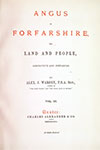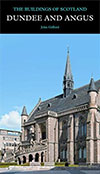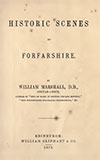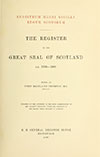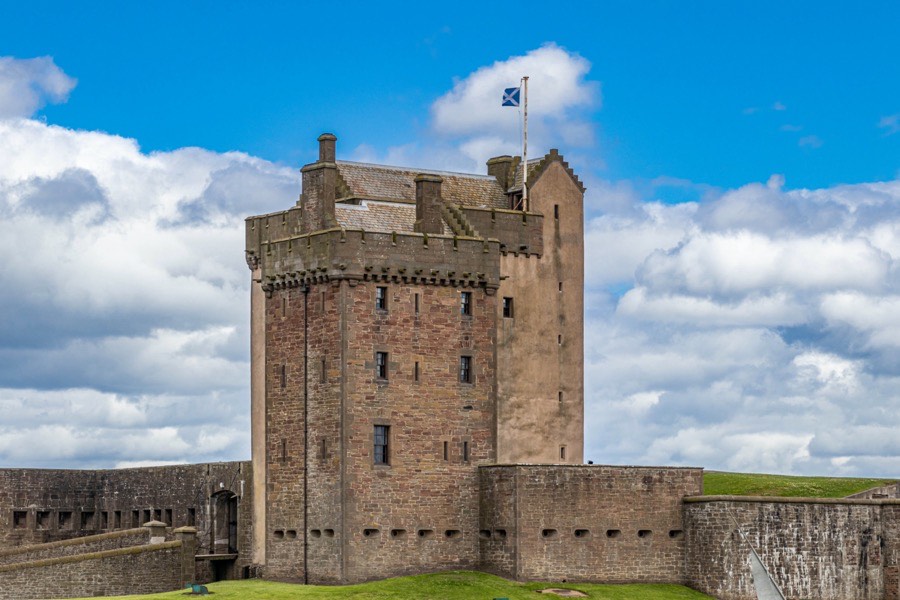

Broughty Castle is a 15th century tower which occupies a strategically-important position at the mouth of the River Tay.
It isn’t clear when the first castle was built at Broughty however by the second half of the 12th century the lands of Portincrag, as Broughty Ferry was then known, were in the possession of Gille Brigte, Mormaer of Angus, as part of the Thanedom of Monifieth. Gille Brigte granted Arbroath Abbey some land there to build a hospital along with a fishery on the Tay. The hospital would have been for travellers using the ferry route across the Tay from Fife.
The crag of Portincrag was a rocky eminence projecting into the Tay to the east of Dundee and a local landmark of some significance. Beside the crag was a harbour which was home to a fishing fleet and the aforementioned ferry, and the Mormaers were entitled to a share of the harbour’s revenues.
Gille Briget’s son, Gille Crist, confirmed the grant to the Abbey in the late 12th century while the main lands of Portincrag continued to be held by the Mormaers until they were forfeited in 1314 by Robert de Umfraville for fighting on the English side at the Battle of Bannockburn. In 1329 Robert the Bruce created John Stewart of Bonkyll the first Earl of Angus and Portincrag passed to his son, Thomas, 2nd Earl of Angus, and his granddaughter, Margaret, Countess of Angus and Mar.
Margaret received a Royal grant of the Crag and fishing of Broughty along with the lands of Ethiebeaton in 1371. She resigned her title in 1389 in favour of George Douglas, her illegitimate son by William Douglas, 1st Earl of Douglas, although she seems to have retained Portincrag at this time suggesting that it was of some importance.
In 1424 James I is said to have granted the Crag and its fishing rights to Sir John Wishart of Pittarrow, although why is not clear. The King was around this time carrying out pre-emptive strikes on nobles he deemed disloyal to the Crown and it may have been linked to this in some way however William Douglas, 2nd Earl of Angus, was in the King’s favour having been knighted at the King’s coronation in the same year.
Wishart is said to have forfeited his estates in 1437 and the King granted them back to the Earl of Angus. The 2nd Earl of Angus died in 1437 and was succeeded by his son, James Douglas, and it may be that this is not a coincidence and that this period of Broughty’s history has become somewhat confused.
The 3rd Earl of Angus was betrothed to Joan, the third daughter of James I, but died in 1446 before he could marry and was succeeded by his brother, George Douglas, as 4th Earl of Angus. The 4th Earl was granted permission in 1454 to build on what was known as the Crag of Brochtie or Brouchtie Rock. It is assumed that he built some kind of fortification as the following year it was described as the principal messuage of the Earldom, although what form it took isn’t known.
The 4th Earl died in 1463 and was succeeded by his son, Archibald Douglas, who resigned Broughty and its fishing into the hands of the infant James III in 1466. In October of the same year the King granted them to David Lindsay, 5th Earl of Crawford, who was made Sheriff of Angus and Keeper of the castle.
The Earl of Crawford was deprived of the office of Sheriff of Angus and the possession of the stronghold of Broughty upon the ascension of the young James IV to the throne in June 1488. In November or December of that year the King granted Broughty and its fishings to Andrew Gray, 2nd Lord Gray, and made him hereditary Sheriff of Angus. In June 1490 Lord Gray received a Crown charter granting him the “rupem de Bruchty”, or rock of Bruchty, then in the barony of Kirriemuir, and its fishing and bestowing upon him the absolute power to build a castle and fortalice on the said rupem, with battlements, iron bars, machicolations, drawbridge and all other necessary fortifications.
The tower may have been completed in 1496 as a stone carved with that date was once to be found inserted just under the battlements on the castle’s north side, although the date may have referred to some other significant event.
Rectangular in plan, the tower is aligned approximately north to south and measures around 13.4m long by around 9.3m wide. Originally it consisted of four storeys plus a garret level within a wall walk.
The main entrance, with a pointed arch door surround that may have been altered in the 1860s, was at ground floor level in the middle of the south façade and led into a lobby off which east and west vaulted basements were accessed to the north.

These basement chambers were probably primarily used for storage but also featured gunloops, with the ones in the east wall of an inverted keyhole design probably dating to the mid- to late 15th century.
From the west of the lobby a short section of straight stair led up through the thickness of the south wall to meet a spiral stair within the thickness of the south-west corner of the castle.
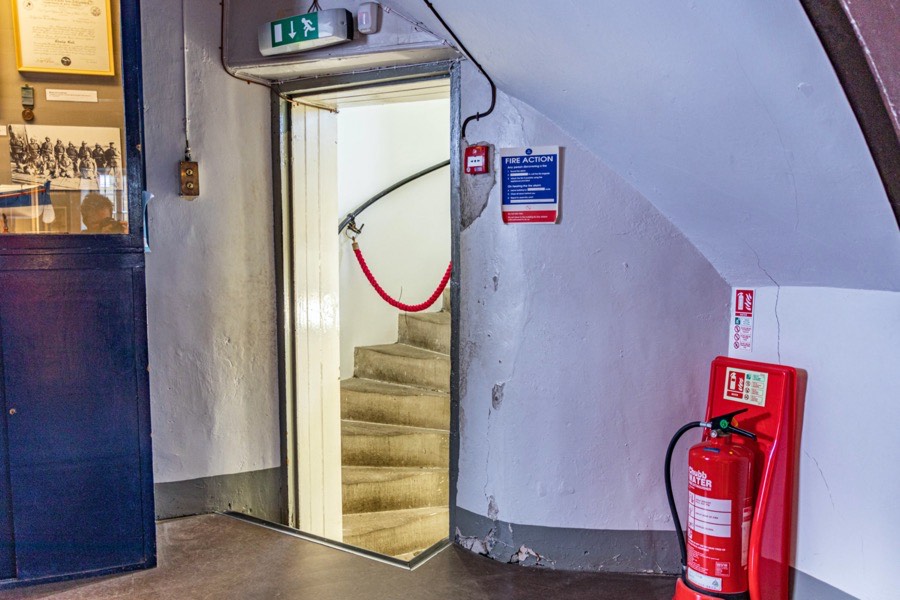
A second spiral stair within the thickness of the north-west corner of the tower was perhaps a service stair.
On the first floor was the Great Hall, at one end of which there may have been a kitchen although substantial remodelling in the 1860s has removed any hint of the layout. Similarly on the second and third floors there would have been accommodation and bed chambers for the laird, lady and guests but the original layouts have been lost. As at similar contemporary castles each floor may have been split into separate chambers by wooden partitions.
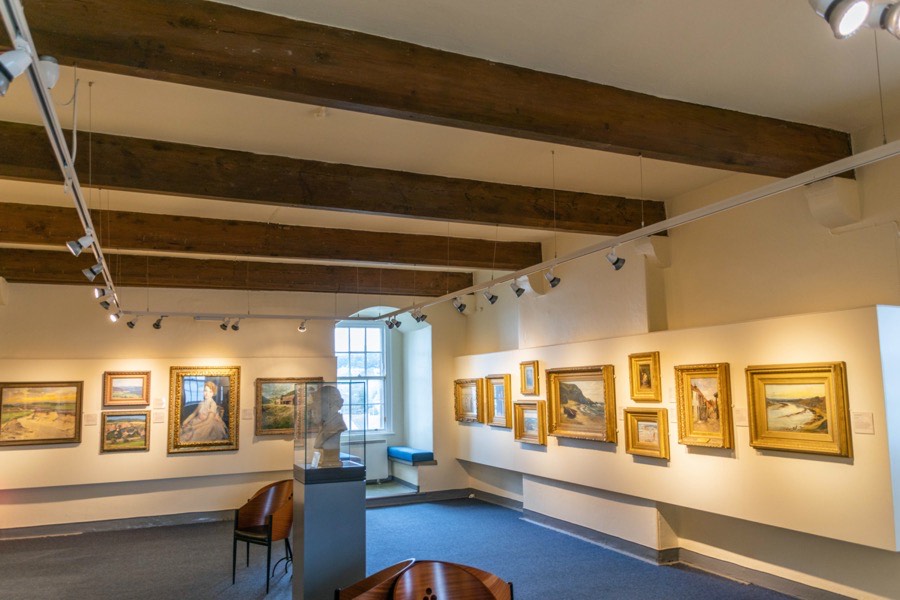
At the top of the staircase there would have been a caphouse providing access onto the parapet walk around the garret. The present caphouse was constructed in the 1860s and so the exact design of the original is not known, however paintings pre-dating the restoration suggest a similar style with the caphouse rising sheer through the wallhead.
The parapet was supported on corbels with slightly projecting square bartisans at each of the other three corners and a bowed projection in the middle of each wall.
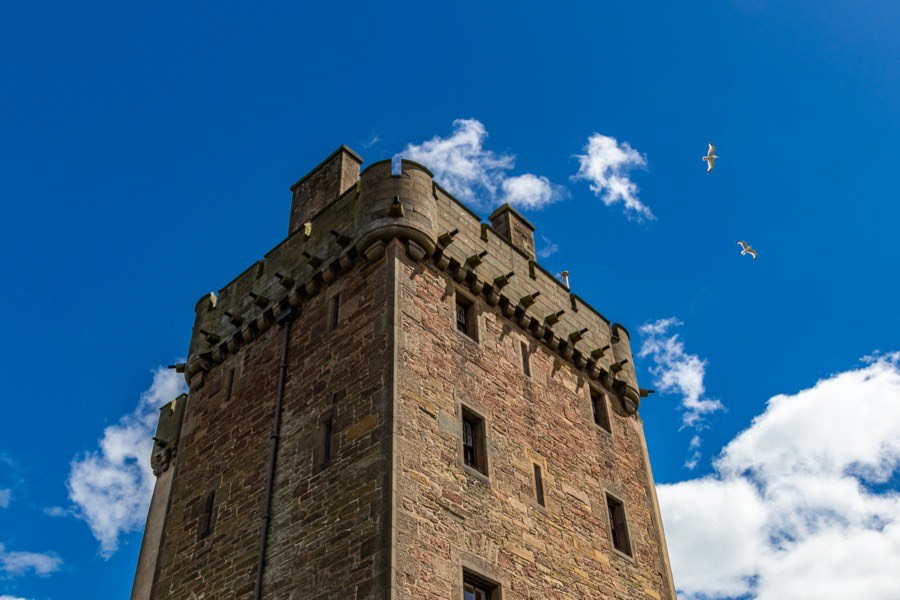
To the south and east of the main tower on the seaward side was a courtyard enclosed by a wall which is thought to have had round towers at the south-west, south-east and north-east corners. These towers probably comprised of two storeys plus a garret although they were later remodelled and only the north-east tower survives. The entrance into the courtyard was to the west of the main tower and reached by an inclined slope.
In 1514 the castle was referred to as “the new fortalice of Broughty”, when Thomas Gray was its “principal keeper”, and it may be that this was due to alterations known to have been made to the castle in the 16th century. A second entrance with a round-arched doorway was added at the north end of the east façade of the main tower. It was probably around this time that the gunloops in the north, south and west walls of the tower were altered.
By the mid-16th century an angled tower stood in the courtyard. The remains of a substantial wall running approximately north-east to south-west and measuring some 2.0m thick were found during an archaeological excavation in 1993 and may represent a part of the tower.
In April 1524 Patrick, 3rd Lord Gray, received confirmation of a grant of numerous lands to him by James V, for his good service, which he had resigned, including the “rupem de Bruchty” with its castle, fortalice and fishing. Lord Gray died in 1541 and in April of the following year the King confirmed a new grant to Patrick Gray of Buttergask of numerous lands including the lands of Crag of Brochty with the castle, fortalice and fishing. Patrick was confirmed as the 4th Lord Gray in September 1542.
The 4th Lord Gray protested in April 1543 that Margaret Moncrieff, widow of Henry Lovell of Ballumby, claimed to have rights to the fishings of Broughty, namely the “fishings adjacent thereto below the wall of the castle of Bruchtie commonly called Stanneris, Fittikinfa and Dindargheid”, and their profits and insisted that she agree to surrender any pretended right that she may have to them.

In March 1547 Patrick Gray, 4th Lord Gray, met the Duke of Somerset during the siege of St Andrews Castle and signed a contract by which in exchange for English help in reinstating his rights over Perth and the return of his brother, who was a hostage in England, he would encourage a marriage between Mary Queen of Scots and Edward VI of England and deliver Broughty Castle and the Spey Tower at Perth to the English army.
Following the Scottish defeat at the Battle of Pinkie in September 1547 an English force under Sir Edward Clinton took possession of Broughty Castle towards the end of the month without a shot being fired, with a garrison being installed under the command of Sir Andrew Dudley. Dudley paid the 4th Lord Gray a sum of £1000 in November of the same year. It was recorded in the Minutes of the Privy Council of Scotland that “our auld ynemies of England hes, by way of deid, taken the craig and place of Broughty and ramforcat them.”
Clinton improved the castle’s defences, aided by an Italian engineer, Giovanni di Rossetti, by digging a ditch across the landward side of the promontory and raising the height of the courtyard wall. In November 1547 the castle’s new defences were tested when James Hamilton, 2nd Earl of Arran and Regent of Scotland, unsuccessfully attempted to retake it with a force of either three thousand or eight thousand men, depending on the source. A further attempt was made in January 1548.
In February 1548 the English built a new fort on nearby Balgillo Hill to the north, later known as Forthill, as it overlooked the castle. The English used the castle “to invaid the burc of Dundie and haill cuntrie, and to burn, herey, sla and destroy” throughout 1548 and 1549. At a meeting on Christmas Day 1549 Mary of Guise decreed that French guns should be brought to Broughty in an attempt to recapture the castle, and Robert Hamilton of Briggis, Master of the Scottish artillery, oversaw the digging of entrenchments for the guns.
A force of some six thousand French and German soldiers under Marshal D’Essé were sent to lay siege to the castle in February 1550. D’Essé was replaced by Paul de Thermes with a reinforcement of one thousand foot soldiers and three thousand horse and on the 20th of February Forthill was captured by Franco-Scottish forces led by Regent Arran. The castle surrendered the following day.
Some sources state that a French garrison occupied the castle for around two months before returning it to Lord Gray, apparently because Henri II, the King of France, didn’t want to incur the cost of supporting the garrison. However other sources state that the French occupied the castle until April 1551 when Henry Lovell of Ballumby seized it and the associated fishing rights from them.
It isn’t clear who held the castle throughout the 1550s, perhaps Lovell, but in 1559 the castle was occupied by members of the Lords of the Congregation led by James Hamilton, Duke of Châtellerault. The Lords were a pro-English Protestant faction opposed to the regency of Mary of Guise, who claimed that they had taken the castle to prevent it falling into French hands as part of a Catholic conspiracy.
In 1568 and 1569 a case was brought before the Lords of Council by Patrick Gray, Master of Gray and son of the 4th Lord Gray, accusing Lovell of seizing Broughty Castle unlawfully.
Sir William Kirkcaldy of Grange and James Balfour of Pittendreich began fortifying the castle for the exiled Mary Queen of Scots in July 1570 as part of a dispute with the pro-English supporters of the infant James VI but abandoned the work.
However by August of the same year Matthew Stewart, 4th Earl of Lennox, better known as Regent Lennox and the head of the pro-English faction, assured England that he was now in control of the castle. In September 1571 the new Regent and head of the pro-English faction, John Erskine, Earl of Mar, requested two “battering pieces”, probably large cannons, from BurtyCrage for his planned siege of Edinburgh Castle. However the castle was seized in the name of Mary’s faction by David Seaton of Parbroath before the cannons could be delivered.
Lord Gray subsequently resumed control of the castle and in January 1575 he and his son and heir apparent, Patrick, Master of Gray, signed a contract at Bruchtie selling to John Lyon, 8th Lord Glamis and Lord High Chancellor of Scotland, various lands in Perthshire. Lord Glamis’ daughter, Elizabeth, married the Master of Gray’s son, also Patrick, in the same year.
By July 1579 part of the lands of Broughty seem to have been owned by the Fotheringhames of Powrie as in that month Thomas Fotheringhame of Powrie agreed to sell to Helen Lindsay, his wife, in liferent, various lands including the eighth part of Bruchtie (which George Keill occupied) with the pendicle of Brouchtie known as the Nethir Marche (which Thomas Robertsoun occupied).
The Lovells of Ballumbie seemingly continued to claim rights to the fishings of Broughty as in February 1581 William Lovell, fiar of Ballumbie, sold the lands and manor of Ballumbie, various other lands, the “fishings adjacent thereto below the wall of the castle of Bruchtie commonly called Stanneris, Fittikinfa and Dindargheid” and various other fishings to David Barclay of Cullerny.
Broughty Castle is shown on Pont’s late 16th century map as the tall four or five storey tower of Brugh-Tay complete with two flanking wings.

Timothy Pont, c. 1583 – 96map image courtesy of NLS
Patrick, Master of Gray and later 6th Lord Gray, is said to have sheltered the fugitive Francis Stewart, 5th Earl of Bothwell, and the Jesuits William Crichton, Robert Hay and Robert Bruce in the castle in 1589. The Earl of Bothwell is said to have later escaped to Caithness from Broughty in 1592.
By this time a group of Catholic earls from the north of Scotland were in rebellion, attempting to impose Catholicism on the monarchy. One of their number, George Gordon, 1st Marquess of Huntly, was reported in England to have paid the Master of Gray £10,000 Scots for Broughty Castle in 1594. Whether or not this was true is unclear as the Gray family were in possession of the castle early in the following century.
In November of the same year Patrick, Master of Gray, with the consent of his father, Patrick, 5th Lord Gray, sold to Robert Flescher, burgess of Dundee, for 3000 merks the salmon fishing of Bruchtie with two lie roundis in the palace of Bruchtie, and the fish house lie rolt fischehous for the preparation and preservation of fish. This suggests that the fishery was operating from two of the round towers and from a vaulted “fishhouse”.
By the early 17th century the castle had fallen into disrepair, with the 5th Lord Gray residing at Fowlis Castle and the Master of Gray residing at Castle Huntly. However in 1607 the Master of Gray returned to Broughty with his wife, Mary Stewart, a cousin of James VI, and the following year became 6th Lord Gray upon the death of his father.
In May 1611 he signed a charter at Fowlis granting to his eldest son, Andrew, Master of Gray, various properties including the rupem de Bruchtie with the castle and its salmon and other fishing. The 6th Lord Gray died in 1612 and his widow, Mary, sold Castle Huntly and continued to reside at Broughty.
In February 1634 Charles I granted the lands and barony of Foullis, the lands of Brughtie with the rupe, castle, salmon and other fishing, and the lands of Balgillo to William Hay, 10th Earl of Erroll and Lord High Constable of Scotland, who had assisted in the King’s coronation at Holyrood Abbey the previous year.
The Earl of Erroll died in December 1636 having suffered financial problems and by 1641 Broughty was back with the Gray family. In August of that year Charles I ratified a charter investing Sir William Gray of Pittindrum, merchant burgess of Edinburgh, in the baronies of Foulles and Fergund and in “the craige of Burghtie, with castle, fortalice, salmond fishing and otheres fishingis therof”. William was married to Anna Gray, the only child of Andrew, 7th Lord Gray, and was granted the right to style himself Lord Gray after his father-in-law’s death.
During the Wars of the Three Kingdoms Broughty Castle was garrisoned by Scottish Royalist forces and it was briefly besieged by Commonwealth forces while General Monck was attacking Dundee. The castle’s garrison “quitted and fled away” on the night of the 31st of August 1651, leaving it abandoned. It seems that Monck didn’t leave a garrison at Broughty although General Alexander Leslie, 1st Earl of Leven, was briefly imprisoned in the castle on his way to the Tower of London.
In June 1655 Lord Gray, John Gray of Crichie and Lady Gray signed a contract of wadset with Mr James Kidd of Craigie whereby Mr Kidd paid the sum of 12,000 merks to William Gray, Master of Gray, who sold and transferred to Mr Kidd “all and haill the craig of Brughtie with the castle, fortalice, salmond fishing, size fish and other fishings belonging thereto” along with various other properties in Angus. In January 1662 James Kidd granted to his son, Patrick Kidd, “the foresaid craig of Brughtie, fortalice, salmond fishing, size fishing and other fishing thereto belonging”.
Andrew, 7th Lord Gray, died in 1663 and was succeeded by Patrick Gray as 8th Lord Gray, Patrick’s father, William Gray, having been killed in a duel with James Carnegie, 2nd Earl of Southesk, in 1660.
The 8th Lord Gray was struggling with debts and so in February 1666 he sold “all and haill the foresaid craig of Brughtie, with the castle, touer, fortalice, salmond fishing, size fishing and others belonging thereto, lyand as said is, and alse all and haill the toun and lands of Northferry and others above narrated” to David Fotheringham of Powrie for 21,000 merks. Fotheringham was the nephew of Thomas Fotheringham of Powrie, the first husband of William Gray’s wife, Margaret Gibson.
Since the properties had been wadset to the Kidds this debt must have been settled and in March 1666 Patrick Kidd of Craigie disposed of them in favour of Fotheringham.
In October 1669 David Fotheringham of Powrie and his son, John, received a ratification from Charles II of various lands including “all and haill the craig of Brughtie, with the lands of Brughtie castle, tour, fortalice, houses, bigings, salmond fishings, fyfe fish and other fishings, and pertinents perteaning to the samen” to be held by David in liferent and to pass to John upon his father’s death.
Patrick Reid, son of John Reid of Knap and heir of his younger brother, John Knap, was retoured in the sixth part of the Castle of Broughty with the salmon fishings, the ecclesiastical lands of Lundie, the sixth part of the town and lands of Balgillo, lands of Ley of Balgillo and the town and lands of Dowcatoune in March 1670. This would suggest that the Broughty lands had been split at some point, although I haven’t been able to find an original source to confirm this.
By February 1692 David Fotheringham of Powrie and the 8th Lord Gray were in dispute regarding the size of the fish of Brughtie. The case was heard before the Lords of Session when Lord Gray seems to have claimed that the size fish were not included in the original transaction. The case was thrown out but the two families were still in dispute three years later when in July 1695 Thomas Fotheringham of Powrie, his father, David, having died, continued the case against the 8th Lord Gray.
The Fotheringhams seem to have been successful in their legal endeavours as in May 1696 Thomas Fotheringham of Powrie was retoured heir to his father in the barony of Brightie comprising of “the foresaid craig of Brughtie, salmond fishing, size fishing and other fishing thereto belonging and containing several other lands and others therein narrated”. The 8th Lord Gray was acquitted of the accusations against him regarding the size fish in June 1703.
During the Jacobite Rising of 1715 the Jacobites gained control of Dundee and installed a garrison at Broughty suggesting that it was still at least in part defensible. The following January James Stuart, The Old Pretender and son of James VII, appointed Alexander Wedderburn, Town Clerk of Dundee, governor of the castle.
Later in the century the castle was abandoned and roofless, its courtyard wall serving as a quarry for local building work, and in 1787 Robert Burns described the castle as “a finely situated ruin jutting into the Tay”.
In 1801 General David Hunter of Burnside, whose ancestors had bought Balgillo and the lands of North Ferry in 1666, began laying out “the New Town at the north ferry”, which later became known as Broughty Ferry. Perhaps in an attempt to cash in on this new interest in the area the Fotheringhams offered Broughty Castle for sale in an advert in the Dundee, Perth & Coupar Advertiser in December 1821 when it was suggested that it could be made into a “delightful residence” for a modest expense despite being a roofless ruin whose vaulted basements were still being used as the shore base of the fishery.
Their attempts appear to have been unsuccessful however as the “Castle, with its fishings and pertinent of eighteen or twenty acres of the adjoining downs or links” was still the property of Mr Fotheringham of Powrie and Fothringham in 1843. However success came three years later when the Fotheringhams sold the castle to the Edinburgh and Northern Railway Company. They built a harbour to the north-west to serve the railway ferry which crossed from Tayport, by which time the courtyard was a jumble of ruins covered with turf.
In 1850 the castle was bought by the Dundee and Arbroath Railway Company who used the vaults for storage but by May 1855 the castle was deemed to be surplus to requirements by the then Edinburgh, Perth and Dundee Railway. With the British Empire fighting the Russian Empire in the Crimean War the castle was sold to the Board of Ordnance, later replaced by the War Office, with plans to refortify it in order to protect the Tay from Russian warships. However the War ended in 1856 before any substantial work was carried out, although the remains of a 16th century gun were found in the ruined north-east tower of the courtyard in the same year.
By the late 1850s there was fear of an invasion by Napoleon III and so it was decided to restore and refortify the castle. Between 1860 and 1861 work was carried out to designs by Robert Rowand Anderson, then working as an architect as with the Royal Engineers, at a cost of some £7000 in what was his first architectural commission. The main tower was rebuilt and roofed, its rubble walls rendered and its interior gutted and remodelled.
Three new windows were inserted into the first, second and third floors of the tower’s north façade, the third floor one being round-headed. Inside the main entrance to the south of the tower a new wall was built to block off access to the vaulted stores which were now used as a magazine and accessed via a new corridor running west from the north-east entrance.
New battlements were added to the top of the tower, supported on the original late 15th century corbels on all sides but the west. Within the battlements a new garret level was constructed with crow-stepped gables, which may not be dissimilar to the ruined original that it replaced. A caphouse, again with crow-stepped gables, was added to the top of the stair at the south-west corner and may incorporate the ruins of the original caphouse which were depicted as still partially standing in a painting of circa 1835.
A new, smaller, four-storey rectangular wing was added to the north-west corner of the castle on a mound built from quarried sandstone, with a new spiral staircase added in the re-entrant angle. To the south of this new wing a small courtyard was created in the re-entrant angle with the main tower. The ground floors of both the new wing and courtyard are pierced with numerous gun-ports.
To the east of the main tower a new segmental-arched entrance was constructed, reached via a stone ramp and drawbridge, with the wall to its east pierced by large, rectangular gun-ports.

The ruins of the old north-east corner tower were removed and a new bastion built, designed to provide covering fire across the new entrance.
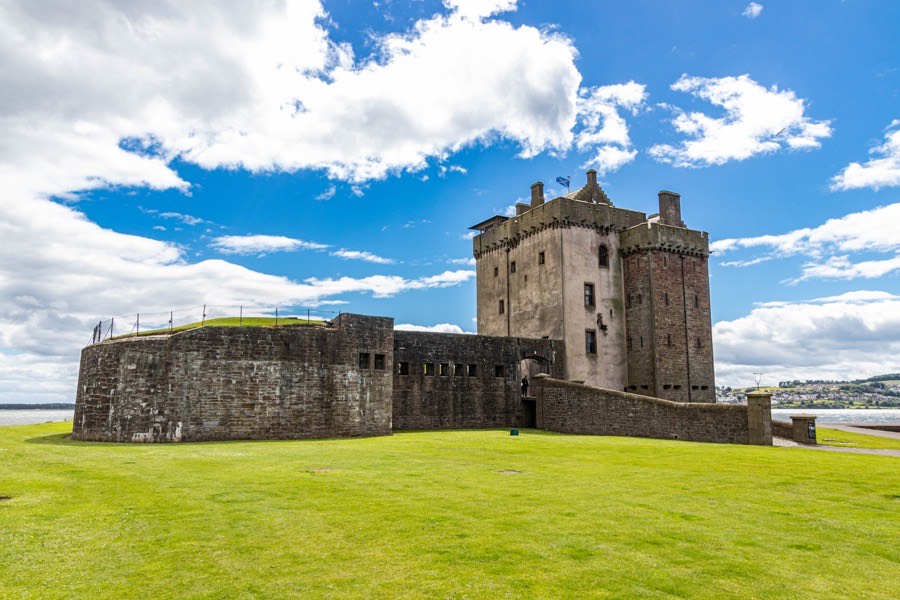
Stretching south and west from this bastion along the east and south edges of the site was a new retaining wall replacing the old courtyard perimeter. Behind the wall was an earthen bank upon which were constructed seven gun emplacements of various sizes and designs,, with two further gun emplacements built on the west side of the courtyard.
At the south-east corner of the new outer wall a caponier was built, outside the walls and accessed via a passageway through the earthen bank, with gunloops for muskets at two levels to allow defensive fire along the south and east walls.

A polygonal bastion was added, projecting west from the south end of the west courtyard wall, to serve as a gun battery, with large, rectangular gun-ports, of a similar design to those in the north wall, piercing its walls.

The courtyard walls were substantially rebuilt with the only original walling surviving on the west side between the main tower and the new south-west bastion.

In 1862 the castle became the headquarters of the Forfarshire Artillery Volunteers however they moved their headquarters to Dundee in 1870 and the castle was subsequently used as a military school.
Anderson’s relatively sympathetic use of the site, restoring the tower house and part of the courtyard wall, was partially-responsible for it soon being seen as outdated, with criticism that the castle’s new defences were vulnerable to attack from warships out at sea and that it was “badly built, badly designed and utterly useless for the purpose”. As a result further work was carried out to the castle’s defences between 1886 and 1887.
From 1888 the castle served as the headquarters for the newly-formed Tay Division Submarine Miners Royal Engineers (Volunteers) who would have laid mines in the Tay in the event of a potential attack by sea. A new range was built to the east of the main tower to provide accommodation for the submarine miners.
Between 1889 and 1891 the castle’s gun emplacements underwent a major remodelling and a magazine was built within Anderson’s western battery outside the original courtyard wall. The ground level of the enclosure to the south of the castle was raised at this time, necessitating the insertion of steps leading down to the tower’s south entrance.
In 1903 a new long-range gun battery was built on the Castle Green to the north-east of the castle complete with two Defence Electric Lights, however perceived military threats had waned by 1910 and the Ministry of Works took over the castle. This position was soon reversed however with the rise of Germany and minor alterations were carried out to improve the castle’s defences. This led to the Ministry of Works complaining in 1913 that the Royal Engineers had made alterations to the tower’s interior without consulting them.
Following the outbreak of World War I in 1914 further minor alterations were carried out to enhance the defensive capability of the castle. A long horizontal slit was cut through the upper level of the caponier at the south-east of the site in order to allow a Maxim gun to cover the shore below.
The castle survived the War without seeing any action but remained a military property until the last of the castle’s garrison left in 1934 and it was transferred from the War Department to the Ministry of Works in 1935. The castle and its grounds were leased to Dundee Corporation in 1938 however following the outbreak of World War II it was requisitioned by the War Department and re-armed and occupied by the 503 Coast Regiment Royal Artillery. In 1942 a brick-built defence post was added to the south-east top corner of the main tower.
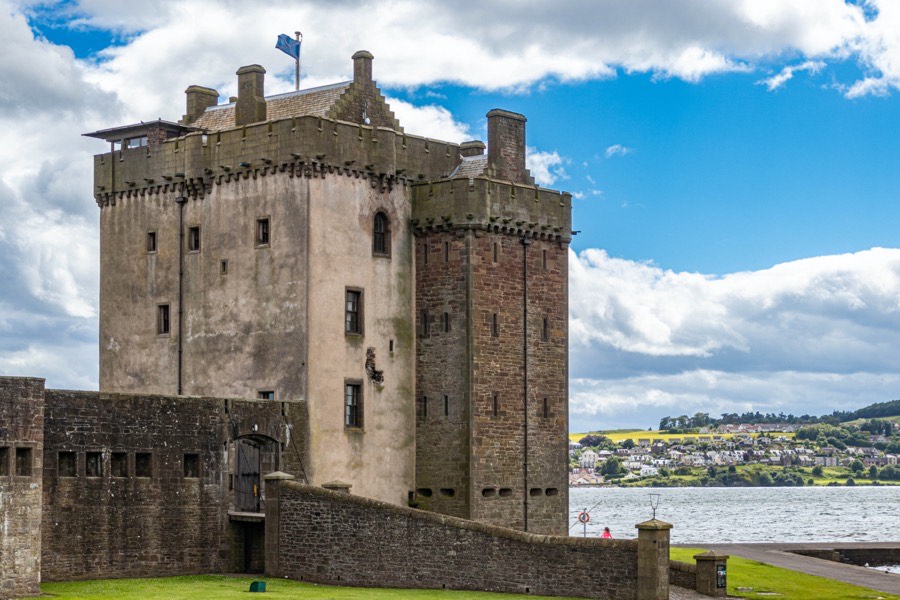
Once again the castle didn’t see any action during the War and in 1945 was returned to the Ministry of Works. In 1949 it was leased once again to Dundee Corporation who in 1950 created a tearoom in the tower house. Permission was sought for Dundee Harbour Trust to use the castle as a Pilot Station. In 1969 the castle was taken over by Dundee Museums and opened as a fishing and whaling museum and in 1973 the castle was transferred to state ownership.
In 1993 an archaeological excavation was carried out in the castle’s courtyard and on the Castle Green prior to the installation of electrical cables for floodlighting. The Castle Green dig revealed terracing deposits associated with the refortification of the site in the 1860s while that in the courtyard revealed the foundations of a 19th century guardhouse and a thick section of walling which might represent a part of an angled tower extant in the mid-16th century.
Broughty Castle is now cared for by Historic Scotland and is run in partnership with Leisure & Culture Dundee who operate a museum within the castle.
Alternative names for Broughty Castle
Breuchti; Breuchtie; Brichteis; Brichtie; Brochtee; Brochtie; Brochtie Hous; Brochty; Broghtie Castel; Brouchtie; Brouchty; Bruchtie; Bruchty; Brugh-Tay; Brughtie; Burghtie; BurtyCrage; Castill of Broughtie; Castle of Brochtie; Castle of Broughty; Castle of Brughty; Portincraig; Portincrag



